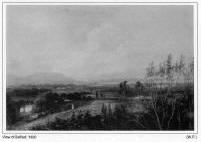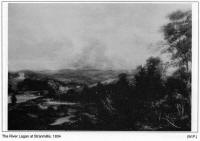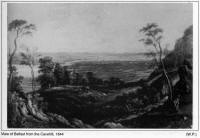
HUGH FRAZER (fl 1813-1861)
Landscape and Portrait Painter
by Gilbert Watson

Hugh Frazer the artist was born in Dromore, Co. Down the son of Hugh Frazer and Agnes Dickson. His mother was the daughter of Joseph Dickson and Jane Colvill a daughter of Rev. Alexander Colvill MD of Dromore.
Frazer, who was the first Ulster landscape painter of note, was admitted as a pupil in the drawing school of the Dublin Society in 1812 and exhibited a sketch with the Society of Artists in Hawkins Street in the following year. He began to exhibit in the Royal Hibernian Academy, Dublin in 1826 and contributed regularly down to 1861. During this period he resided at Dromore, Belfast or Dublin.
He was elected an Associate of the Royal Hibernian Academy in May 1830 and became a Member in May 1837.
He lived in Belfast in 1834 and painted a "View of Belfast, taken from the Curator's house in the Botanic Gardens" which was exhibited in the Commercial Newsroom, Waring Street and was subsequently advertised by the artist to be disposed of by ballot.
Frazer wrote an "Essay on Painting" in 1825 which was printed by Alexander Mackay, junior and published by M Jellett, Belfast and by James Burnside, Capel Street, Dublin.
His endeavours, in conjunction with Belfast resident artists Nicholas J Crowley, Joseph Molloy, Samuel Hawksett, Robert Warrington, J W Millar, F La Moile and the brothers William and Andrew Nicholl, were instrumental in the formation of the Belfast Association of Artists. The Association held the inaugural exhibition in 1836 in the great room of the Museum, College Square North, by permission of the Natural History Society.
Hugh Frazer had been unanimously elected President and wrote the preface to the catalogue in which the views and objectives of the Association were presented in an `Address to the Public.'
`In any general address to an enlightened public of the present day, it would be quite uncalled for to advance any propositions, or arguments, as to the importance of the cultivation of Art to the community, both in its extensive moral influence as an universal language, expressive of poetic sentiment and emotion, and, as a medium of objective knowledge; and, also, in its merely ornamentive branches, furnishing to social life some of its most attractive elegancies and refinements; in short, as constituting the leading external attribute of high civilization.'
`The backward state of the Arts in Ireland, and more particularly in the North, compared with other parts of the empire, has been remarked, with regret, by those who take comprehensive views of their capabilities, when cultivated with an enlightened spirit, in refining public taste, and in adding beauty and harmony to the ornamental branches of manufactures.'
`Taking into consideration the limited demand for productions in the higher departments of Art, and the humble position they hold in artistical attainment, when compared with other incorporated Societies of British Artists, the Belfast Association submit their first Exhibition of Modern Art to the Northern public, in the hope that their exertions will meet that approbation and support, which will enable them to furnish an annual display, at least equal to the present one.'
`They trust they will not be thought presuming too much on their own position, in appealing to a liberal and enlightened public, for their co-operation in raising a fund, by subscription, for the purpose of erecting an appropriate building for an Institution of Fine Arts in the Northern metropolis, to which object the surplus proceeds of the present Exhibition are to be devoted.'
`The present Exhibition must be considered as an experiment, in regard to the measure of support and encouragement which the public may concede to this mode of advancing native Art, also, how far the resident Artists would be enabled to sustain an Annual Exhibition.'
J. Millar, an Architect and one of the exhibitors, displayed an interior view of the `Public Entrance Hall and Statue vestibule leading to the Staircase of Antique Sculpture' which was one of a series of drawings for the Proposed Ulster Gallery of Fine Art. Despite the enthusiasm the enterprise failed after three annual exhibitions.
The first exhibition catalogue included 217 items with Frazer contributing twenty-five paintings comprising Irish, English and Welsh landscapes as well as continental views in the Apennines and the Mediterranean coast of Spain. Specific Irish landscape views were entitled Lough Derg, Old Corn Mill Co. Wicklow, Stevenson's Mills, Springfield, Bryansford River, Old Flax Mill, Co. Down and Moonlight, Dublin Bay. He also exhibited a portrait of Hamilton Rowan taken in his 80th year.

|
 |
| River Lagan at Stranmillis, 1834 | View of Belfast from the Cavehill, 1844 |
At the 1838 exhibition, Frazer who was then Professor of Painting to the Royal Hibernian Academy, a position he held until 1853, remained as President and contributed eight paintings. In addition to landscapes and a family group he has `The faction fight, on the evenings of the fair' which was accompanied by the following note in the catalogue.
`The Irish Faction fight, which is now, happily for the advance of the morals and civilization of the country, a matter of history, presented a curious study of human nature, excitement, and animal spirits; and, however violent and extraordinary its form of demonstration, the social feeling seemed the leading impulse of the Irishman, in the faction fight: a hearty exchange of hard knocks of the shillelagh, seemed rather a demonstration of friendly, than angry or revengeful, feeling towards his neighbour, The leading incidents of the picture, which is intended to illustrate a trait of national character, all came under the painter's personal observation.'
The artist's address is given as Dromore in 1836 and Kennedy's Place, Shankill Road Belfast in 1838.
The works which survive are almost exclusively landscapes and Frazer is best known for his views of Belfast and County Down. The views of Belfast and the Lagan Valley are valuable topographical records but the standard of work varies greatly. His work is represented in the collection of The Belfast Harbour Commissioners and the Ulster Museum. A view of Waringstown in the museum's Local History Department is his best work with fine brushwork and detail.
After 1861 the life of Hugh Frazer remains a mystery as Strickland records his resignation from membership of the Royal Hibernian Academy in that year "owing to future absence from Dublin and perhaps from Ireland" and his name does not appear again as an exhibitor, nor is there any further account of him.
BIBLIOGRAPHY
Paintings, Sculptures and Bronzes in the Collection of The Belfast Harbour Commissioners, Catalogue by Eileen Black, 1983.
A Catalogue of the Permanent Collection: 3 Irish Oil Paintings 1572-c1830, Eileen Black Ulster Museum 1991.
Art in Ulster: 1 By John Hewitt, 1977.
A Dictionary of Irish Artists, Two Volumes, Dublin, 1913, Walter G. Strickland.
Exhibition of the Belfast Association of Artist Catalogues 1836, 1838.
Landscapes of Belfast, Exhibition Notes, Ulster Museum 1977.
The Royal Ulster Academy of Arts - A Centennial History by Martyn Anglesea, 1981.
Dickson Family Notes by J M Dickson, PRO T1765/1-9
PAINTINGS
The paintings are illustrated by kind permission of The Belfast Harbour Commissioners and represent Nos. 10,11,14 and 15 from the collection catalogue.
12/11/2003
